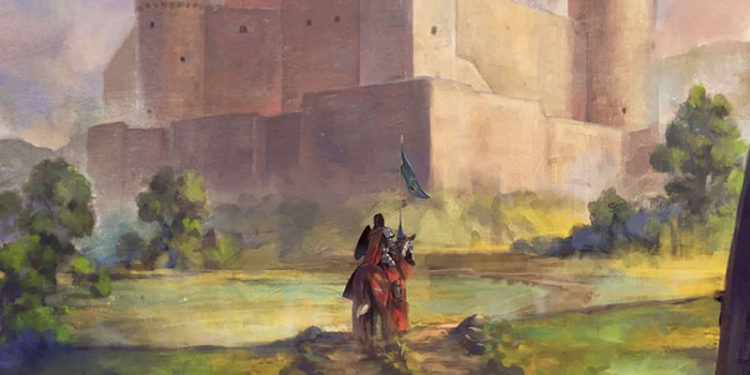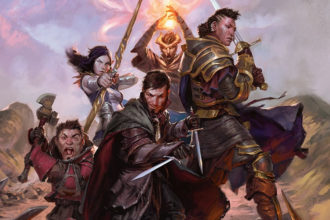Strongholds & Followers Breakdown, Part Four

Okay, I meant to be writing my breakdown on Mythic Odysseys of Theros, working from the DDB text, but instead Cerberus ate my homework. (Translation: my brain just refuses to engage properly right now to work from DDB text.) Instead, I’m finishing up a series that has been sitting unfinished for far, far too long: MCDM’s Strongholds & Followers.
Part One | Part Two | Part Three | Part Four
Warfare
The section opens with a summary on the things that make mass combat rules hard to design, because the text needs to justify the extremity of its abstraction. Just like individual-scale combat systems, mass-combat systems position themselves somewhere on the scale of granularity and fidelity; this is pretty far out on the low-granularity end.
There are units, as we established in the previous sections. They each have various stats: Attack, Power, Defense, Toughness, Morale, Size, possibly other traits. What they don’t have, during battle, is positioning. If you want a narrative of maneuver and relational tactics, be prepared to do most of your own heavy lifting. All units of the same type “stack” into the same larger unit, increasing the Size die, but they have to share all of their keywords to stack.
Those keywords are [Experience] [Light/Medium/Heavy/Super-heavy] [Ancestry] [Unit Type]. For unit types, there are seven: levies, infantry, archers, cavalry, flying, fortifications, and siege engines. The definitions of these are what you would expect, and they have a lot to do with what each unit is allowed to do in battle. I’ll come back to that.
The central thing to understand about each unit’s stats is that Attack is, you know, a bonus to their attack roll, in a contested roll against the enemy’s Defense (no idea why it’s a contested roll, but okay). If the attacker wins that, they make a contested Power roll against the enemy’s Toughness. If the attacker wins that, the defender’s casualty die goes down by one die face.
The text takes great pains to deny that this is two attack rolls, but the writer doth protest too much. Sorry, one of the whole points of the D&D damage roll, part of the game since 1974, is that any successful hit makes progress. This doesn’t do that, and it has the effect of slowing down battles substantially. Four die rolls to find out nothing happened… this is Not The Way. This is a mess for many of the same reasons as trying to clean up the math for followers in standard combat is a mess.
If a casualty die falls to half the value it started the combat with, or if the unit is a levy, it becomes diminished. Diminished is a unit condition that means the unit makes a DC 15 Morale save each time it reduces its casualty die, immediately reducing its casualty die again. Other effects can also force Morale saves, as you’d expect.
There are a few pages of tables to support constructing your own units and advancing the provided units. With some mathematical spindling, folding, and mutilating, this becomes a Cost – so you have a cost to hire, you maintain them for 10% of that, and you can compare their strength to other units.
Then there’s a “sample attitude chart,” slightly expanded from when Gygax put one of these in AD&D 1e, and… I dunno, a big chart of racial hatreds is not my favorite thing. This chart’s real purpose is to govern unit hiring costs outside your character’s own ancestry. Admittedly, I have a hard time with how zombies feel about my ancestry mattering, when I’m thinking about adding them to my army. Back in Part Two of this breakdown, I talked about ambassadors – well, here’s the payoff.
Units can improve equipment, experience, and size. Heavy infantry being just better than light infantry is one of those things that only works in the total absence of movement or maneuver rules. Anyway, experience increases without spending money, while equipment and size upgrades cost money or a roll on your class’s followers table.
Let’s Get to the Action
Basically, you only track each unit on each side, since they have no position – or maybe you want to think of it as “everyone must use the standard order of battle.” The rules look like there will be an awful lot of grinding the opponent down, two contested dice rolls at a time. Outnumbering an opponent helps, sort of, but three d4-sized units probably have a substantial advantage over a single d12-sized unit, because they get three times as many chances to deal one “click” of damage, and numbers don’t affect Attack or Power rolls. Sure, they’ll be diminished after they each take just two hits, but… in that time you’ve potentially dealt six damage to the d12 unit.
There are a bunch of other wrinkles in the system – ancestry features, charge attacks, engagement and disengagement, who can attack who – but the core is as simple as that. The right to attack or immunity to attack is such that there’s no way for levies or infantry to ever harm cavalry, by the rules as written, even when the cavalry have engaged with them. That… doesn’t make a ton of sense, and misses the whole nature of polearms, especially pikes. But maybe the special case of being engaged beats the general case of infantry-can’t-attack-cavalry? If so, they needed a clearer way to say this.
You can rally a unit once to bring to back up to 1 on the casualty die after it would fall to 0. This is nice to have, though by that point you don’t really want to use them if you have any other option. If you can get them to survive the fight at all, they’ll heal more or less on their own: one point the day after the battle, and two weeks to heal the rest of the way up to a d4. Anyway.
I’m glossing over a few more details here, but I’ve highlighted what I believe are fundamental problems: too many dice rolls with nothing happening, and a misstep in action economy versus unit size.
Simple Warfare
I’m going to be honest, most books that include a mass-combat system don’t also include an emergency backup system. Called the Simple Warfare system, it cuts out a lot of the d20 rolls in exchange for some significant up-front number-crunching. There’s a single d100 roll, with modifiers for each side – a combination of numerical/strength advantage and morale/situational advantage.
The two warfare systems care about radically different things: the first cares about WHO your forces are (that is, ancestry is the main source of special features), while the second elides almost all ancestry features in a point value, but cares deeply about each army’s recent past and current conditions. “Hereditary enemies” are a +20% bonus, but I’m not sure why you’d even list this – presumably both sides of the fight receive that adjustment? (To say nothing of, you know, being a game-mechanical payoff for overt racial hatred. But even on the game’s own premises this doesn’t work.)
Once you determine who wins based on that contested d100 roll, avec modifiers, you go to applying casualties. This is the first place that we see any reason for unit sizes to be dice values, or any way for a single very large… unit… to deal more damage than a larger number of small units. It’s also a lot clearer how you could hope for a miraculous victory of a smaller force over a larger one. You know, the kind of heroic narrative that we’re all hoping to create through cleverness, inspiration, or any other kind of heroic ethos.
The real downside of the Simple Warfare system is that it might not resolve the situation in one d100 roll followed by a small number of d-whatever rolls. If neither side loses enough forces to make them retreat… you recalculate everything and take it from the top. The text nods at objectives – that is, anything other than “kill them all and let the gods sort them out” – but doesn’t discuss what they might be or how they might be achieved. Maybe paradoxically, finding a way to incorporate this might have simplified resolution, by making sure the battle was resolved in a single roll. Maybe 2-3 consecutive d100 rolls, since each side can come to the field with their own strategic objectives.
Both of these systems feel like they are minimally invested in delivering on the fantasy of military command. Specifically, the text repeatedly makes explicit its assumption that people who want to use this product want to use it as little or as lightly as possible, and haven’t really bought in to leading armies. Folks, if you don’t have a minimum level of player buy-in on a game’s core activities, downplaying them won’t help.
Overall, Simple Warfare emphasizes more interesting things and uses the system’s mechanics in a more interesting way. It does have the side effect of making you not care what’s good about your soldiers – high cost is high force advantage, end of story. That’s definitely simpler.
New Items
We’re almost done now. There’s a collection of new magic items, with a heavy emphasis on cosmic artifacts. Man, I wish more of the book were explicitly centered around the codices. This part conjures up Master of Magic for me, easily one of my favorite video games of all time. That’s actually one of the ways in which S&F is an unusual book: its core goal is presenting a three-part rules module, but it’s also obliquely presenting Matt’s setting.
Anyway. The Codices are hugely powerful, game-changing artifacts, and it’s hard to imagine that you wouldn’t casually steamroll any opponent who wasn’t backed up by a different Codex. In addition to a bunch of very substantial powers, they also have cosmology-altering powers and/or let you summon whole units for battle. Some of these could use some help to get into formal 5e rules language. For other features, I’m just delighted that they’re allowed to be weird and over-powered, for an appropriate cost. Matt gives a half-page of commentary on how Codices can work in a campaign, a much-needed inclusion.
There are a variety of other magic items as well – weapons and cloaks and magical furniture for your stronghold. The weapons all summon a Servitor creature on a critical hit. There haven’t been a lot of magic items that go deep on creative proc effects, and these are wild.
As usual, though, I don’t think going item-by-item with magic item commentary is going to be useful or interesting reading, so (the last three paragraphs notwithstanding) I’m skipping it.
“Three Paragraphs Notwithstanding” was the name of my spoken-word-poetry-slam group in college. We began a lot of sets but, for some reason, never finished one.
Sample Unit Cards
The book closes out with a bunch of sample units and a template for unit cards. There’s not much intrinsically remarkable here, except insofar as monster units are nice to have.
Conclusion
I so wanted to like this book. It does have some very good content – the monsters are still a standout, for concept and artwork. The rest of the mechanics have things I’m not wild about, whether that’s uneven Class Feature Improvements or warfare mechanics that seem like they’re failing at action economy. I don’t want a whole other wargame that feels like it should be independent of the core loop of gameplay, but this isn’t it either. For me – your tastes may vary, and that’s okay.
In any level of granularity or fidelity of mechanics, for any kind of game, something is getting skipped. That’s the nature of representation, as a concept. It’s kind of like clone degradation (you know, re-presentation), but adding deliberate simplification for ease of use. If I ever get around to writing that History of D&D Mass Combat Rules series, you’re going to be hearing a mighty lot of this.



